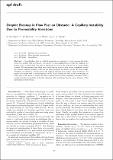| dc.contributor.author | Protière, S. | |
| dc.contributor.author | Bazant, Martin Z. | |
| dc.contributor.author | Weitz, D. A. | |
| dc.contributor.author | Stone, H. A. | |
| dc.date.accessioned | 2012-02-22T15:57:46Z | |
| dc.date.available | 2012-02-22T15:57:46Z | |
| dc.date.issued | 2010-12 | |
| dc.date.submitted | 2010-09 | |
| dc.identifier.issn | 0295-5075 | |
| dc.identifier.issn | 1286-4854 | |
| dc.identifier.uri | http://hdl.handle.net/1721.1/69152 | |
| dc.description.abstract | In multiphase flow in confined geometries an elementary event concerns the interaction of a droplet with an obstacle. As a model of this configuration we study the collision of a droplet with a circular post that spans a significant fraction of the cross-section of a microfluidic channel. We demonstrate that there exist conditions for which a drop moves completely around the obstacle without breaking, while for the same geometry but higher speeds the drop breaks. Therefore, we identify a critical value of the capillary number above which a drop will break. We explain the results with a one-dimensional model characterizing the flow in the narrow gaps on either side of the obstacle, which identifies a surface-tension–driven instability associated with a variation in the permeability in the flow direction. The model captures the major features of the experimental observations. | en_US |
| dc.description.sponsorship | Harvard University (MRSEC (DMR-0820484)) | en_US |
| dc.description.sponsorship | Schlumberger-Doll Research Center | en_US |
| dc.language.iso | en_US | |
| dc.publisher | Institute of Physics Publishing | en_US |
| dc.relation.isversionof | http://dx.doi.org/10.1209/0295-5075/92/54002 | en_US |
| dc.rights | Creative Commons Attribution-Noncommercial-Share Alike 3.0 | en_US |
| dc.rights.uri | http://creativecommons.org/licenses/by-nc-sa/3.0/ | en_US |
| dc.source | Prof. Bazant via Erja Kajosalo | en_US |
| dc.title | Droplet Breakup in Flow Past an Obstacle: A Capillary Instability Due to Permeability Variations | en_US |
| dc.type | Article | en_US |
| dc.identifier.citation | Protière, S. et al. “Droplet Breakup in Flow Past an Obstacle: A Capillary Instability Due to Permeability Variations.” EPL (Europhysics Letters) 92.5 (2010): 54002. | en_US |
| dc.contributor.department | Massachusetts Institute of Technology. Department of Chemical Engineering | en_US |
| dc.contributor.department | Massachusetts Institute of Technology. Department of Mathematics | en_US |
| dc.contributor.approver | Bazant, Martin Z. | |
| dc.contributor.mitauthor | Bazant, Martin Z. | |
| dc.relation.journal | EPL (Europhysics Letters) | en_US |
| dc.eprint.version | Author's final manuscript | en_US |
| dc.type.uri | http://purl.org/eprint/type/JournalArticle | en_US |
| eprint.status | http://purl.org/eprint/status/PeerReviewed | en_US |
| dspace.orderedauthors | Protière, S.; Bazant, M. Z.; Weitz, D. A.; Stone, H. A. | en |
| mit.license | OPEN_ACCESS_POLICY | en_US |
| mit.metadata.status | Complete | |
